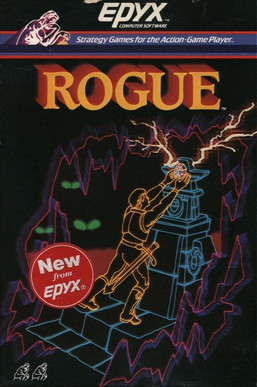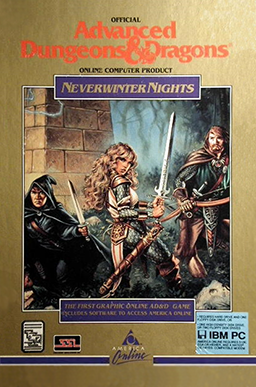
A bulletin board system (BBS), also called a computer bulletin board service (CBBS), is a computer server running software that allows users to connect to the system using a terminal program. Once logged in, the user performs functions such as uploading and downloading software and data, reading news and bulletins, and exchanging messages with other users through public message boards and sometimes via direct chatting. In the early 1980s, message networks such as FidoNet were developed to provide services such as NetMail, which is similar to internet-based email.
A multi-user dungeon, also known as a multi-user dimension or multi-user domain, is a multiplayer real-time virtual world, usually text-based or storyboarded. MUDs combine elements of role-playing games, hack and slash, player versus player, interactive fiction, and online chat. Players can read or view descriptions of rooms, objects, other players, and non-player characters, and perform actions in the virtual world that are typically also described. Players typically interact with each other and the world by typing commands that resemble a natural language, as well as using a character typically called an avatar.

Rogue is a dungeon crawling video game by Michael Toy and Glenn Wichman with later contributions by Ken Arnold. Rogue was originally developed around 1980 for Unix-based minicomputer systems as a freely distributed executable. It was later included in the Berkeley Software Distribution 4.2 operating system (4.2BSD). Commercial ports of the game for a range of personal computers were made by Toy, Wichman, and Jon Lane under the company A.I. Design and financially supported by the Epyx software publishers. Additional ports to modern systems have been made since by other parties using the game's now-open source code.

GEnie was an online service created by a General Electric business, GEIS, that ran from 1985 through the end of 1999. In 1994, GEnie claimed around 350,000 users. Peak simultaneous usage was around 10,000 users. It was one of the pioneering services in the field, though eventually replaced by the World Wide Web and graphics-based services, most notably AOL.
A massively multiplayer online game is an online video game with a large number of players to interact in the same online game world. MMOs usually feature a huge, persistent open world, although there are games that differ. These games can be found for most network-capable platforms, including the personal computer, video game console, or smartphones and other mobile devices.

Air Warrior was a multiplayer online combat flight simulation game launched by Kesmai in 1987. It was hosted on GEnie and used that service as a server for client software running on a variety of personal computers. It underwent continual improvement through its decade-long lifetime with Kesmai, appearing on new platforms and host services. Electronic Arts purchased Air Warrior in 1999, and became provider of the game, but it was discontinued in 2001. Sequels Air Warrior II and Air Warrior III were both released in 1997 and published by Interactive Magic.
StarText was an online ASCII-based computer service run by the Fort Worth Star-Telegram and the Tandy Corporation and marketed in the Dallas-Fort Worth Metroplex newspaper circulation area from May 3, 1982 until March 3, 1997. Its name was derived from Star and Text.
DECWAR is a multiplayer computer game first written in 1978 at the University of Texas at Austin for the PDP-10. It was developed from a lesser-known two-player version, WAR, adding multi-terminal support for between one and ten players. WAR and DECWAR are essentially multiplayer versions of the classic Star Trek game, but with added strategic elements. The game was later used, by scrubbing copyright notices and replacing them, as MegaWars on CompuServe and Stellar Warrior on GEnie. Both versions ran for years.
Dungeon was one of the earliest role-playing video games, running on PDP-10 mainframe computers manufactured by Digital Equipment Corporation.
Kesmai was a pioneering game developer and online game publisher, founded in 1981 by Kelton Flinn and John Taylor. The company was best known for the combat flight sim Air Warrior on the GEnie online service, one of the first graphical MMOGs, launched in 1987. They also developed an ASCII-based MUD, Island of Kesmai, and empire building game, MegaWars III, which ran on CompuServe, and later, GEnie.

A text game or text-based game is an electronic game that uses a text-based user interface, that is, the user interface employs a set of encodable characters, such as ASCII, instead of bitmap or vector graphics.
MegaWars was a series of real-time online multiplayer space empire building games which were hosted on CompuServe in the 1980s and lasted well into the 1990s. The original MegaWars I was a port of Decwar, originally developed at the University of Texas at Austin. A port using a basic client/server protocol and a basic graphical interface on the TRS-80 Color Computer as MegaWars II was never released. MegaWars III followed, based on an entirely different engine originally developed by Kesmai.

Neverwinter Nights was an early graphical multiplayer online role-playing game, which ran from 1991 to 1997 on AOL.
Island of Kesmai was an early commercial online game in the multi-user dungeon (MUD) genre, innovative in its use of roguelike pseudo-graphics. It is considered a major forerunner of modern massively multiplayer online role-playing games (MMORPGs).
The history of massively multiplayer online games spans over thirty years and hundreds of massively multiplayer online games (MMOG) titles. The origin and influence on MMO games stems from MUDs, Dungeons & Dragons (D&D) and earlier social games.
Online games are video games played over a computer network. The evolution of these games parallels the evolution of computers and computer networking, with new technologies improving the essential functionality needed for playing video games on a remote server. Many video games have an online component, allowing players to play against or cooperatively with players across a network around the world.
MegaWars III was a massively multiplayer empire building game written by Kesmai and run continuously on CompuServe between 1984 and 1999. It was one of CompuServe's most popular games throughout its lifetime with thousands of players joining the month-long game cycles. It was only shut down after CIS was purchased by AOL and moved to the web-based "CompuServe 2000" interface that would not cleanly support it. A modified version, Stellar Emperor ran for much of the same time period on GEnie, also ending in 1999 when that service was shut down by General Electric. A new version of Stellar Emperor, sporting a new client-server GUI, was run for a short period on Kesmai's GameStorm.

Air Warrior III, known as Air Warrior 3 in Europe, is a video game developed by Kesmai Studios and published by Interactive Magic and Midas Interactive Entertainment for Microsoft Windows in 1997. The game had been scheduled to be released in January 1998, before being pushed forward for December 15, 1997.
John R. Taylor III is an American computer game designer, serial entrepreneur and massively multiplayer online game pioneer. He is a co-founder of the game company Kesmai, which they founded in 1981. In 2011, Taylor was awarded the Online Game Legend Award by the Computer Game Developers Association.







